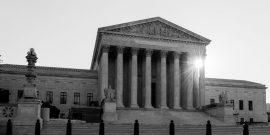The Supreme Court is independent, yes, but Congress has several options for exercising control over the justices.
Our Two Supreme Courts
Speaking at Northwestern University Law School this semester, Justice Elena Kagan may have revealed more than she intended. Amidst her entertaining and witty remarks, she described two very different kinds of discussions that take place at the conferences where the justices decide cases. In shorter conferences, the justices, in order of seniority, with the Chief going first, state their votes with brief statements of reasons. Justice Kagan observed that shorter conferences tend to be the high profile cases that appear on the front page of the newspaper. She surmised that further debate in these cases would likely make her colleagues irritated with those of opposing views.
She then described longer conferences, where the justices after stating their positions—sometimes tentative ones– entertain more general deliberations, trying to figure out exactly what the right answer should be. They then focus on and often resolve thorny legal questions. Justice Kagan said that during her time on the Court one of the longest conferences revolved around an obscure jurisdictional issue of the kind that would draw no public attention.
Justice Kagan’s remarks are consistent with my view that we have not one but two Supreme Courts. One is a political court, in which the justices play the aristocratic element in a mixed political regime. Today our aristocratic element consists not of landed nobles but the cognitive elite well represented in judiciary by those who graduated from the nation’s best law schools. But like the aristocratic element that Aristotle described long ago, one of its functions is to restrain the democratic element, here represented by the state and federal legislatures. The other is a legal court where the justices act as real lawyers.
In the legal court, justices largely agree on their methods of judicial resolution. Substantial deliberation may thus be mutually profitable. Bankruptcy and the Employment Retirement Security Act are paradigm cases for this court. Generally these cases are decided with a high degree of consensus, if not unanimity. In the political court, many, if not most of the justices, simply have preferences rather than serious methods, and their preferences sharply diverge, now along partisan lines. Given their lack of a common legal language, let alone shared preferences, there is no more reason for deliberation at the Court in these cases than there would be among politicians on a congressional committee. Less reason, in fact, because more often than legislation, cases have binary outcomes and do not allow for compromises that take time to forge.
The only way to go back to one Supreme Court is for the justices to approach constitutional issues– even those that stir passions like same-sex marriage–with the same formal rigor that they do bankruptcy and ERISA. Until that time, we will have two Courts, where the political nature of one is less apparent to the public because of the legal nature of the other.

